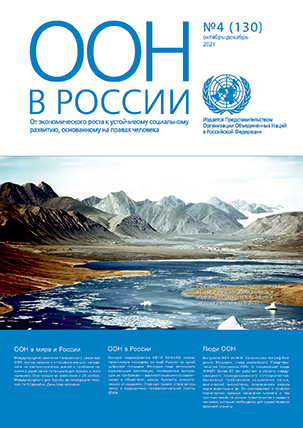New strategy needed in Russia to address worsening demographic trends
- Argues a new report by the United Nations Development Programme -
Moscow, 24 April, 2009 – New policies are needed in Russia to address demographic challenges that seriously threaten the country’s economic and social security, finds a new Human Development Report, ‘Russia Facing Demographic Challenges’, which is being released today.
Despite the fact that the acute nature of Russia’s demographic problems has been officially recognized, and efforts are being made to mitigate them, it will not be possible to overcome negative demographic trends in the foreseeable future without a comprehensive, well-designed, consistent, and long-term strategy.
“It is not possible to attain noticeable changes in 10-20 years even in the best scenario. Russian society must comprehend these problems and search for answers in the economic and social spheres, - says Anatoliy Vishnevsky, Director of the Institute of Demography, Higher School of Economics, one of the lead authors. “There are some things that can be changed through successful policy, e.g. reduction in the mortality rate - our top priority, and an increase in the birth rate. But there are some things that we cannot influence: for example, the aging population”.
The Report emphasizes that the design and implementation of an efficient strategy in response to demographic challenges requires three components – political will, economic resources and specific knowledge.
Russia has been grappling with a demographic crisis for a long time: short life expectancy, low birth rate, shrinking and aging population, and lack of clear immigration policy.
As a result, Russia lost over 12 mln people during the last 16 years. Although it was partially compensated by migration ( 5,7 mln. ), the number of inhabitants of Russia at the beginning of 2008 was 142 mln. people.
According to the forecasts of the Russian Statistical Committee, by 2025 the natural decrease in the population of Russia will exceed 11 mln. people; the loss of the working-age population will be 14 mln. people; the number of persons of pension age will increase by approximately 5 mln. people.
The Report suggests two directions for design of strategic responses to demographic challenges: to “repair” the demographic situation where it is possible and to adapt to what cannot be repaired.
The first direction includes radical change the mortality rates, increase of life expectancy as well as healthy life expectancy by promoting an active and conscientious attitude on the part of ordinary people to their own health, helping to control mortality due to avoidable causes of death associated with modern life. The most important of them are cardiovascular disease in relatively young age groups and external factors, the latter particularly among men. The share of deaths due to external causes in Russia is almost three times bigger than in the West.
The second consists of adaption of public, government and social institutions to certain demographic trends that cannot be changed.
Due to the overall aging of the population, the authors of the Report call for adaptation of social institutions, public health, social security and education systems to the needs of the older population.
If, for example, Russia is successful in attaining sustainable rise of fertility, this will be a sign of successful ‘demographic repairs’. However, it will be a long time before children who are born today reach the labor market, and, moreover, the birth of a second or third child may drive many women out of a job. So intensification of the economy is indispensable to adapt to the shrinkage of the labour force.
Reduced mortality in middle-age groups will improve the situation on the labor market, but later it will increase pressures on the pension system, which will need to undergo reform.
Compensatory international migration, if used as a tool for ‘demographic repairs’, will help to fill or reduce demographic gaps due to population decrease, adverse changes in the age structure, and geographic population distribution. However, international migration is only a feasible solution if Russian society can become adjusted to it. This involves special efforts to change mass consciousness, social institutions and government attitudes.
Each of the above examples is indicative of the extremely important role of the demographic component as a driver for human development and all national economic and social development in coming decades.
The Human Development Concept used by the UN Development Programme, includes demographic, economic and social development. Longevity and health of people serve as the basis for expanding of people’s choice, creative life, welfare, and education. The life expectancy index is included in the calculation of the Human Development Index. The report contains HDI for the regions of the Russian Federation. Specifically, the life expectancy index pulls downward the overall Human Development Index for Russia in comparison with other countries.
The role of demographic policy is increasingly (though somewhat belatedly) becoming clear to Russian society and its intellectual and political elite. However, Russia is still at the very beginning of a long road – concludes the Report.
For additional information, please contact Victoria Zotikova, UNDP Communications Aanalyst at +7 495 787 21 15/769 97 91 or by E-mail: Victoria.Zotikova@undp.org
***
UNDP is the UN's global development network, advocating for change and connecting countries to knowledge, experience and resources to help people build a better life. We are on the ground in 166 countries, working with them on their own solutions to global and national development challenges. As they develop local capacity, they draw on the people of UNDP and our wide range of partners.
Photo:
Professor Sergei Kapitza reading the report at the presentation
Sascha Graumann, UNDP Resident Reprisentative a.i. in Russia, opening the discussion at the Report presentation
Participants of the presentation collecting copies of the UNDP Report

